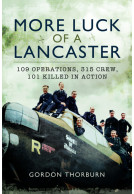RAF Bomber Command at War 1939–45 (Hardback)
Imprint: Pen & Sword Aviation
Pages: 192
Illustrations: 80 black and white illustartions
ISBN: 9781526700513
Published: 5th March 2021
(click here for international delivery rates)
Order within the next 10 hours, 41 minutes to get your order processed the next working day!
Need a currency converter? Check XE.com for live rates
| Other formats available - Buy the Hardback and get the eBook for £1.99! | Price |
|---|---|
| RAF Bomber Command at War 1939–45 ePub (21.0 MB) Add to Basket | £6.99 |
The Royal Air Force had placed a great deal of faith in its force of bombers, Bomber Command, in the event of a future war. The belief in the ability of formations of bombers flying in daylight and unescorted, protecting themselves from enemy fighter attack, informed early tactics but led to bloody losses. Hampered by government restrictions on targets, by late 1941 Bomber Command was in crisis.
As a result, and coupled the growing dire war situation, a new and forceful commander, Sir Arthur Harris, was appointed and new strategies allowed Bomber Command to broaden its attacks despite some opposition. The result was the area bombing strategy which focussed attacks upon enemy held towns and cities. This Main Offensive period lasted throughout 1943-1944 and saw both victories and defeats. It was also the period that saw a limited number of precision attacks; on Augsburg, Peenemunde and, most famously, the Ruhr dams.
Bomber Command also aided in tactical and strategic support for the invasion of Europe and the subsequent fight to push inland. New technological developments allowed Bomber Command to hit V-Weapons sites and to focus more on precision bombing, but Harris remained determined to hit German towns and cities whenever possible, while the Command's growing power allowed it to rain devastation upon its targets, culminating at Dresden.
Much has been written about Bomber Command, but this book focusses largely on those who took part in the raids and on public attitudes towards the campaign in Britain. Using accounts from national and local archives, newspapers and existing historiography, the book seeks to shed light on untold stories from Bomber Command’s war.
"...a good story of the events facing Bomber Command and its personnel throughout the period."
Air Power History
Featured in
Newsletter from the Air Transport Group of the Railway and Canal Historical Society - 2 Aug 21
A photo section gives a visual extra to the book, including photographs of various aircraft, such as an early production Wellington 1A, Hampden, and a stunning photographs of three Stirlings, over British fields, with the squadron letters having been blacked out by the censor. Alongside the photographs of many young crewmen who did not make it home, there a striking photographs of Leslie Thomas Manser, V.C. is included.
Jon Sandison
The book provides a quick and efficient overview of the role of Bomber Command in the War, it sets the principal campaigns in context, and it reviews both its achievements and its shortcomings.
The Military Historical Society
Craig Armstrong is one of the Pen & Sword authors I do like to read as I have read a few of his books before (South East Northumberland at War, Orkney and Scapa Flow at War & Tynemouth in the Great War), these books are always well written with good detail and ‘story’ telling but you’re not overly swamped with facts and details to deter the non-technical fan. This book is just the same and makes for a very good read, for a 192-page book you can’t get everything into the book you might need, but Armstrong has written a good book that covers all the main bases. I actually think it would make a good book for the newbie or the student who wants to learn more about the subject. Certainly a book I would recommend to others for a very good read.
UK Historian
5 stars
Read the full review here
“Despite its grim detail it is still a very interesting book and one which will prove enlightening even to those already well-read on the Bomber Command actions of WW2.
Philip Styles – Archivist, The Shackleton Assn
Congratulation to Craig Armstrong on producing one of the most balanced works of this still controversial subject”.
About Dr Craig Armstrong
Born and bred in Northumberland, Dr Craig Armstrong is an experienced historian,with a special interest in the history of the North East of England and Scotland. He works as a freelance author and has taught history at both Newcastle University and Northumbria University.




















